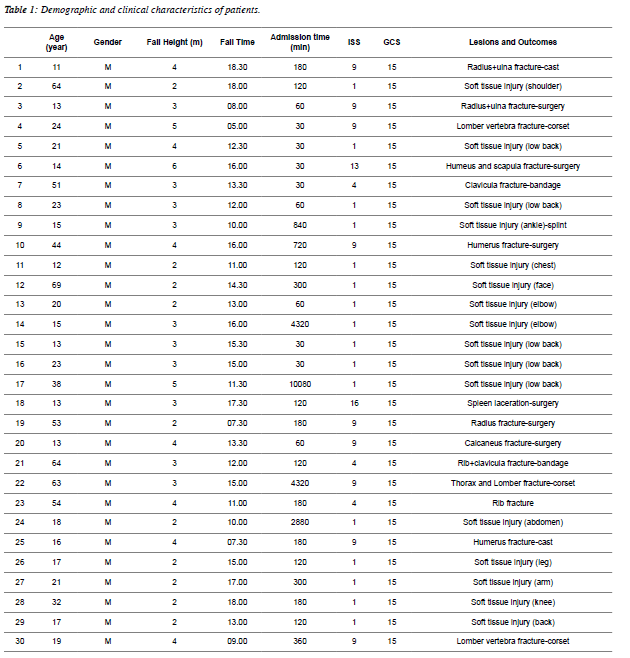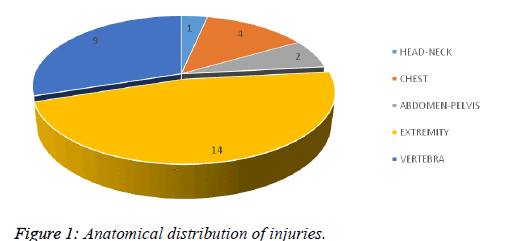Keywords
|
| Apricot tree, Emergency department, Fall from tree. |
Introduction
|
| Falls compose of an important part of emergency department (ED) admissions due to trauma [1]. In children, it is the first reason why they are admitted to the ED, but in adults it is the second cause of admitting, following traffic accidents [2]. There are many factors which affect the mortality and morbidity in fall patients, such as fall height, cause of fall, type of ground on which the patient fell, the injured body parts and victim’s age [3]. |
| Especially, in rural areas where the agricultural activity is intensively made, tree falls form a great subset of falls from height. Maybe, it is underestimated but a lot of deaths due to falls from trees is seen in the literature [1,4]. In this sense, apricot tree (Prunus armeniaca) which has an 8-12 metres (m) height has been an important cause of falls from height. Turkey is the leader of apricot producing countries in the world and Malatya region, where we live in, farms more than half of this production [5,6]. Because of the heavily apricot agriculture in our region, we encounter a lot of falls from apricot trees in the harvest season. |
| There are a few studies about falls from tree in the literature but no study for apricot tree falls. Therefore, in the present study, we aimed to describe the characteristics and clinical consequences apricot tree falls and also to contribute the literature about this unmentioned subject. |
Materials and Methods
|
| We examined the patients, admitted to Inonu University medical school emergency service between June 2015 and September 2015, with a history of falls from apricot tree prospectively. All data were recorded on standard forms and studied in detail with regard to patient age, gender, falls height, falls time, ED admission time, vital signs, types of injuries, treatment variations, Glasgow coma score, and injury severtity score. |
| Data analysis was performed with statistical the software (SPSS for Windows, Version 16.0, SPSS Inc., Chicago, IL, USA). Descriptive statistics were reported including means ± standard deviations (SD), and percentages. Percentages were rounded. |
Results
|
| In the present study, thirty patients admitted to the ED with fall from apricot trees throughout the three months. All of these cases were male. The mean age of patients was 29 ± 18.9 years (range 11 to 69) and 10 (33%) patients were in pediatric age group. 19 (63.3%) patients fell from tree at 12.00-18.00 o’clock period. The mean admission time was 14.6 ± 34.7 hours. The range of fall height was 2 to 6 metres (m) and the mean was 3.1 ± 1.1 m. All of the patients were conscious and the mean of their Glaskow Coma Scores (GCS) was 15 points. The mean of Injury Severity Score were determined as 4.4 ± 4.5 points (Table 1). |
 |
| The majority of patients suffered from mild injuries. The injury site according to anatomy was extremity injury in 14 (46.7%), vertebral injuries in 9 (30%), chest injuries in 4 (13.3%), abdomino-pelvic in 2 (6.7%), and head-neck injury in 1 (3.3%). Totally, sixteen (53.3%) patients had only soft tissue injuries such as abrasions, ecchymosis, ligament injury etc. The most common injury was seen bone fractures. The localization of fractures was humerus in 3 (10%), radius-ulna in 3 (10%), clavicula in 2 (6.7%), vertebra in 3 (10%), costa in 2 (6.7%), and calcaneus in 1 (3.3%) (Figure 1). |
 |
| Generally, most of the patients (70%) were managed and discharged from the ED, 5 patients who had extremity injury were cast or splinted and the remaining 16 patients were given analgesics and medical advices (elevation, ice, rest) in ED. We observed all of the patients for about 6 to 24 hours after the trauma. In this period, we checked blood samples (complete blood count, liver and renal function parameters) routinely. 5 (16.7%) of those patients were taken to orthopedics department and had surgical interventions. Three patients were admitted to neurosurgery department and one patient to general department. There were no deaths in our study and all of our patients recovered fully (Figure 2). |
 |
Discussion
|
| Apricot is a small fruit tree which is approximately 8-12 meters tall and has got a dense spreading canopy. It has been known since ancient times and has an important nutritious role in human life. The motherland of apricot is Armenia, but nowadays, it has been mostly farmed in Turkey [5]. Turkey produces the highest amount of apricot worldwide and more than half of this production is done in Malatya, in the east region of Turkey [6]. Apricot has an important role in economy of the country and agriculture is intensively performed in harvest time. Hence, a lot of apricot tree falls could be seen in that season. |
| Literature data suggests that males more commonly suffered from tree falls [1,7,8]. Our study concurred, and all of our patients were male. The reason why is the insufficient mechanization, and predominant manpower farming of apricot agriculture. In addition, the male-dominated society structure in the rural areas is also an important factor. |
| Dakouré PW et al. [9] demonstrated that 76.4% of injuries occurred in individuals aged<15 years and Negin J et al., [8] found that 85% of injuries occurred in individuals aged<20 years in a larger study with 7651 patients. However, in the study by Özkan et al. [4] about walnut tree falls, all of the cases were adult patients, and the mean age was 48.5 years. In the present study, we determined the mean age as 29 years and the pediatric age proportion as 33%. We believed that the different heights of the trees and the fragile, slippery surfaces of the tree branches were the reasons for these variable results. |
| In our study, the mean of the fall height was 3.1 m and the maximum height was 6 m. It is not possible to compare other studies because there are no apricot tree falls in the literature. However, Ozkan et al. [4] found the mean fall height to be 5.2 m in a walnut tree falls study, and another tree falls study carried out in Iran determined the highest fall as 7 m [10]. |
| All of our cases were conscious, had normal GCS and the mean of ISS was 4.4 points. 63.3% of falls happened between 12.00-18.00 hours, in which farming activity is mostly performed. The mean duration between the injury time and admission to hospital was 14.6 hours. Ersoy et al., [1] determined admission time to be 77.96 minutes, Baba et al., [11] determined 7.2 hours in their studies. The present study had a longer admission time comparing to literature because the patients mostly had minor injuries. |
| In the literature, head injury, vertebral injuries and extremity injuries comprise the bulk of injuries in people who fall from height [2,3,9,11]. In the present study, extremity injuries (46.7%), spinal system injuries (30%) and thorax injury (13.3%) were seen descendingly. The mostly fractured bones were humerus (3), radius (3), and vertebra (3). We determined one spleen injury and he was operated upon successfully. Only five of the patients were treated surgically by the orthopedic department. None of the vertebral fractures were not underwent surgery. The remaining patients (70%), were managed and discharged from the ED. Overall, all of our patients recovered fully without any disability. |
Conclusion
|
| In the present study, we found important data. Firstly, we determined that apricot falls mostly cause minor injuries and no deaths; however extremity and vertebral fractures are sometimes seen also. Secondly, the short height of the apricot trees and the soft or grassy character of the ground, which the patient fell on, are the major reasons for this low risk trauma. Additionally, the emergency department has an important role in the management of apricot tree falls, because 70% of the patients were managed and discharged from an ED. Lastly, 66.7% of the cases who required surgical intervention were in the pediatric age group. These results showed that children were affected worse than adults. Thus, the rules for child worker should be explained clearly and obligations must be fulfilled by the government. It will absolutely reduce the number of tree fall injuries to children. |
|
|
References
- ErsoyS,SonmezBM,YilmazF,KavalciC,OzturkD,ey al.Analysisandinjurypaternsofwalnuttreefallsincentralanatoliaofturkey.WorldJEmergSurg2014;9:42.
- YavuzMS,TomrukO,BaydarCL,KüpeliA.Evaluationofaccidentalfallfromhighcaseswhoadmittedtoemergencyservice.JournalofForensicMedicine2004;18:8-12.
- Içer M,Güloglu C,OrakM,Ustündag M.Factorsaffectingmortalitycausedbyfallsfromheight.UlusTravmaAcilCerrahiDerg2013;19:529-535.
- OzkanS,DumanA,DurukanP,AvsarogullariL,IpekciA,et al.Featuresofinjuriesduetofallsfromwalnuttrees.TurkishJournalofEmergencyMedicine2010;10:51-54.
- https://en.wikipedia.org/wiki/Apricot.
- ErcisliS.ApricotcultureinTurkey.ScientificResearchandEssay2009;4:715-719.
- GuptaA,ReevesB.Fijianseasonalscourgeofmangotreefalls.ANZJSurg2009;79:898-900.
- NeginJ,VizintinP,HouasiaP,MartiniukAL.Barkingupthewrongtree:injuriesduetofallsfromtreesinSolomonIslands.MedJAust2014;11:698-700.
- DakouréPW,DialloM,TraoréAV,GandémaS,BarroSD,et al.TraumarelatedtofallsfromtreestreatedinaspecializedtraumacentreinBurkina-Faso-onehundredandsixcasestreatedinoneyear.IntOrthop2015.
- ZargarM,KhajiA,KarbakhshM.InjuriescausedbyfallsfromtreesinTehran,IslamicRepublicofIran.EastMediterrHealthJ2005;11:235-239.
- BabaAN,PaljorSD,MirNA,MaajidS,WaniNB,etal.Walnuttreefallsasacauseofmusculoskeletalinjury-astudyfromatertiarycarecenterinKashmir.UlusTravmaAcilCerrahiDerg2010;16:464-468.
|


